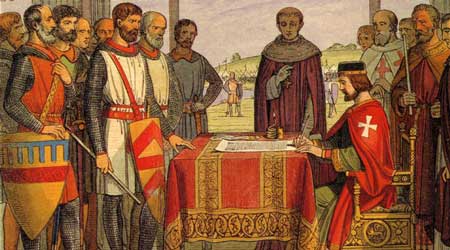Description
Through an in-depth analysis of primary and secondary sources, students in this lesson will identify, understand and be able to explain the basic ideas contained in the Magna Carta of 1215, why King John was forced to sign it, why the document forms the foundation for the English constitution, and why the Magna Carta is seen today by many historians as a founding document in constitutional and parliamentary democracy.
Subjects
Civics and Government
European History
World History
US History
Grade Level
11-12Duration
90 minutesTour Links
- Westminster Abbey
- Parliament
- British Library
Essential Questions
- What was the Magna Carta (Great Charter) of 1215? What were its provisions?
- Why is the Magna Carta (Great Charter) of 1215 considered to be one of the most important founding documents for constitutional and parliamentary democracy, both in the United States and around the world?
- Why did our founding fathers look to the Magna Carta (Great Charter) of 1215 for inspiration during the American Revolution?
- What is the link between the Magna Carta (Great Charter) of 1215 and the US Constitution of 1787?
Key Terms
- British Library
- Constitution
- Founding fathers
- Habeas Corpus
- Human rights
- King John I
- Political rights
- Rule of law
- UK National Archives
- US National Archives
The Magna Carta of 1215… a document Winston Churchill in his four volume work The History of the English Speaking Peoples called a “law which is above the King and Parliament, and which even He and They must not and may not legally break”, radically altered England’s political and social history. Never again would a monarch be able to rule English citizens simply by the force of his will. Over the centuries, generations of children would be taught that the Magna Carta had established the dearly held principles of habeas corpus, trial by jury and the rule of law so central to their identity as English citizens. During the American Revolution, men such as Thomas Paine and Thomas Jefferson would seek to link the Magna Carta to the idea of “no taxation without representation” and the legacy of citizens standing against tyranny.
Through an in-depth analysis of primary and secondary sources, students in this lesson will identify, understand and be able to explain the basic ideas contained in the Magna Carta of 1215, why King John was forced to sign it, why the document forms the foundation for the English constitution, and why the Magna Carta is seen today by many historians as a founding document in constitutional and parliamentary democracy.

- Students will identify, understand and be able to explain the provisions of the Magna Carta (Great Charter) of 1215 and why it was signed by King John.
- Students will identify, understand and be able to explain the reasons how the Magna Carta (Great Charter) of 1215 formed the foundation for British constitutional protections and the “rule of law.”
- Students will be able to identify, understand and be able to explain the link between the Magna Carta (Great Charter) of 1215 and the liberal ideas held by many of the founding fathers during the era of the American Revolution.
- Students will be able to identify, understand and explain how the basic concepts of the Magna Carta (Great Charter) of 1215 served as a foundation for ideas behind limited government and human rights in the US Constitution of 1787.
To view resource web pages, download the lesson plan PDF above.
I. Anticipatory Set
- Writing / Question: What are the basic and fundamental rights due all citizens? (5 min)
- Handouts – Copies of the Magna Carta and readings from the websites listed below (5 min)
II. Body of Lesson
- Lecture / PPT – The Magna Carta of 1215 (20 min)
- Video – The Magna Carta (10 min)
- Independent Activity – Students read the articles on the Magna Carta from the UK and US national archives, taking notes as appropriate (25 min)
- Group Activity – Discussion on the Magna Carta as a foundation for civil, political and human rights and how it links to the ideas of the founding fathers and the US Constitution (15 min)
III. Closure
- Assessment – Essay: What provisions of the Magna Carta (Great Charter) of 1215 laid the foundation for political thought and basic human rights as articulated by the founding fathers during the era of the American Revolution? Be sure to give examples from the texts.
- Homework Assignment: Identify the rights and basic freedoms modern US citizens hold today. Give examples and be prepared to discuss in class.
Extension
On tour: British Library
While on tour, students can visit the British Library, located at 96 Euston Road in London, where they can see for themselves a surviving copy of the Magna Carta (one from 1297), along with thousands of other exhibits from Great Britain and from around the world. The library also has an interactive exhibit on the document.

